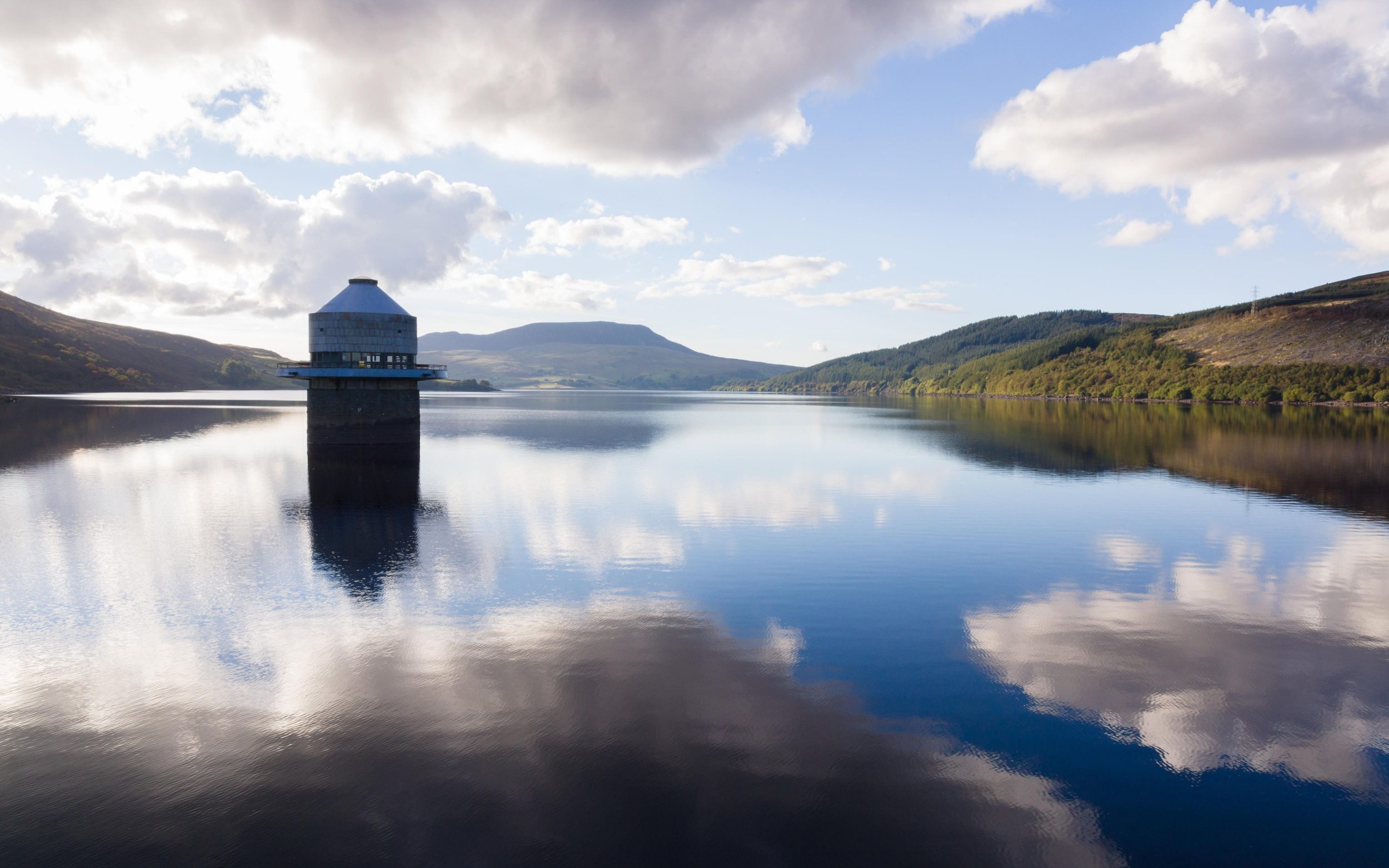
Llyn Celyn Reservoir, constructed between 1960 and 1965, stands on the site of Capel Celyn, cleared of its inhabitants to provide fresh water for the people of Merseyside – David Pimborough/Alamy
For the people of the valley, it was just another day – farmers milked their cows, rapids poured down the hills into the creaming turbulence of the Tryweryn river, and the schoolroom reverberated to the sound of English lessons. At night, the lilts and tones of Welsh poetry could be heard rising into the sky as farmers gathered around harps – in the valley, all the farmers were poets and all the poets were farmers. But little did they know, there were aliens in their midst.
In the fields, on the edge of town, appeared men in trench coats and wellington boots sinking their spades into the soil, measuring the depth of the rock, photographing the landscape and making notes. A few villagers asked them what they were doing but their answers were evasive, and they soon disappeared. Life continued in the remote rural community in North Wales as it had for centuries.
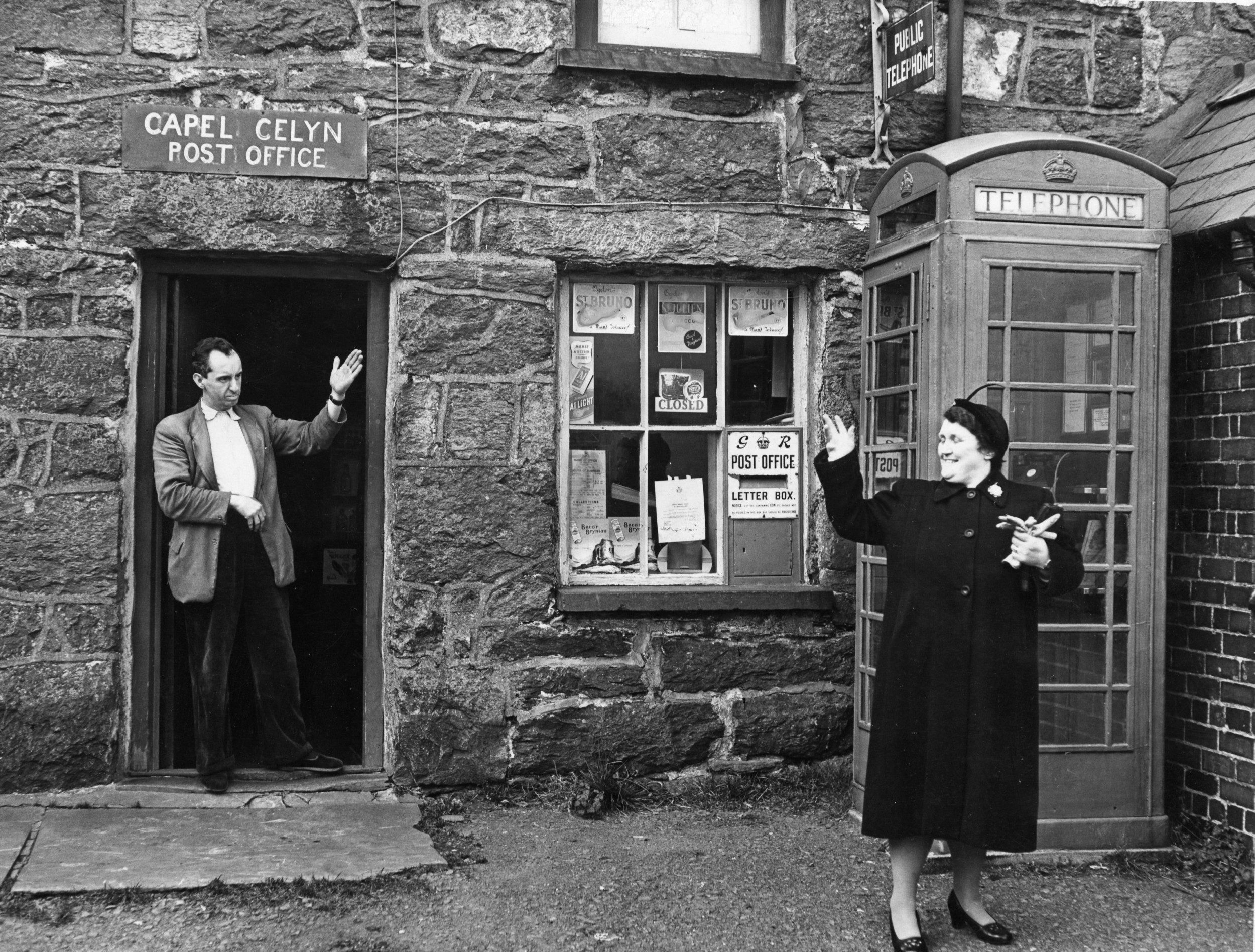
The postmaster Jones Parry waves to a customer outside his post office at Capel Celyn in December 1956. At this stage, plans had already been announced to flood the village – Mirrorpix/Getty
Three months passed. Some of the villagers were sitting down for breakfast. It was five days before Christmas, 1955. They glanced at a paper, the Welsh edition of the Liverpool Daily Post. There was the usual quota of good news and bad. Then, at the top of page two, something no one was expecting. Their village, Capel Celyn, was to be drowned.
The walk to the valley, from the hills of Bala, takes around five hours. When I visited, 60 years after that fateful headline, the peaks were shrouded in mist, the sun puny behind a thick veil of cloud; it was hard to tell where the mist ended and the skies began. Eventually, I arrived at the eastern end of an enormous reservoir, quivering in the silver gloom of the late-afternoon light. In front of an electricity pylon was a stone building spray-painted with the words “Cofio Celyn” – Remember Celyn – along with the spider-like insignia of the “Free Wales Army”.
Visitors are often struck by the restfulness of the lake, belying the area’s traumatic past. But when I visited, the water seemed restless, imprisoned, pent up. Not far from the southern shore, a forlorn concrete structure rose from the water: the drawing-off tower, the orifice through which water was sucked out – or stolen. Somewhere down there, beneath the little rippling waves, was the stub of the chapel after which the village is named. And it was here, in 1956, that the beleaguered locals gathered, as their enemy’s strategy was uncloaked.
Liverpool, apparently, was running out of water. To sustain its industry and provide water for Merseyside, it was in dire need of a new reservoir. Six locations were considered. This was soon whittled down to two, both in Wales. The Tryweryn valley had one of the biggest watersheds in Wales. Water could be channelled into the River Dee, to be extracted at Chester, supplying Liverpool with 60 million gallons per day. Yes, there was the small matter of flooding a village and a dozen of its outlying farms, but the Liverpool Corporation was confident there would be no hard feelings because Great Britain was a “tight little island” and this was a “just” and “necessary” measure. A blizzard of questions arose from the church pews that day.
Was this legal? Potentially, yes. The Corporation could bulldoze a private members’ bill through an English-MP-dominated Parliament to obtain a compulsory purchase order. Did they not have to take Welsh opinion into account? No. What would happen if the villagers simply refused to leave their homes? They were probably going to find out.
The Capel Celyn Defence Committee whirred to life with the selfless teacher Elizabeth Watkin Jones, who had grown up in the village post office, as its secretary. She was friends with Gwynfor Evans, the leader of the Welsh nationalist party, Plaid Cymru. A passionate advocate for cultural nationalism, particularly the protection of the Welsh language, he described Tryweryn as “the most important of all our battles”.
Over the months and years ahead, in large part thanks to these two, the iniquities of Liverpool’s scheme were debated and denounced, not just within the valley but all over Wales and beyond, in pubs, chapels, societies, newspapers, and on radio and television. The odds were not good: a rural David pitted against a corporate Goliath. But Watkin Jones in particular proved a woman of Herculean diplomatic prowess. The Committee implored people to write, and write they did, in their thousands. The red dragon of Wales had roared to life and was ready to breathe fire.
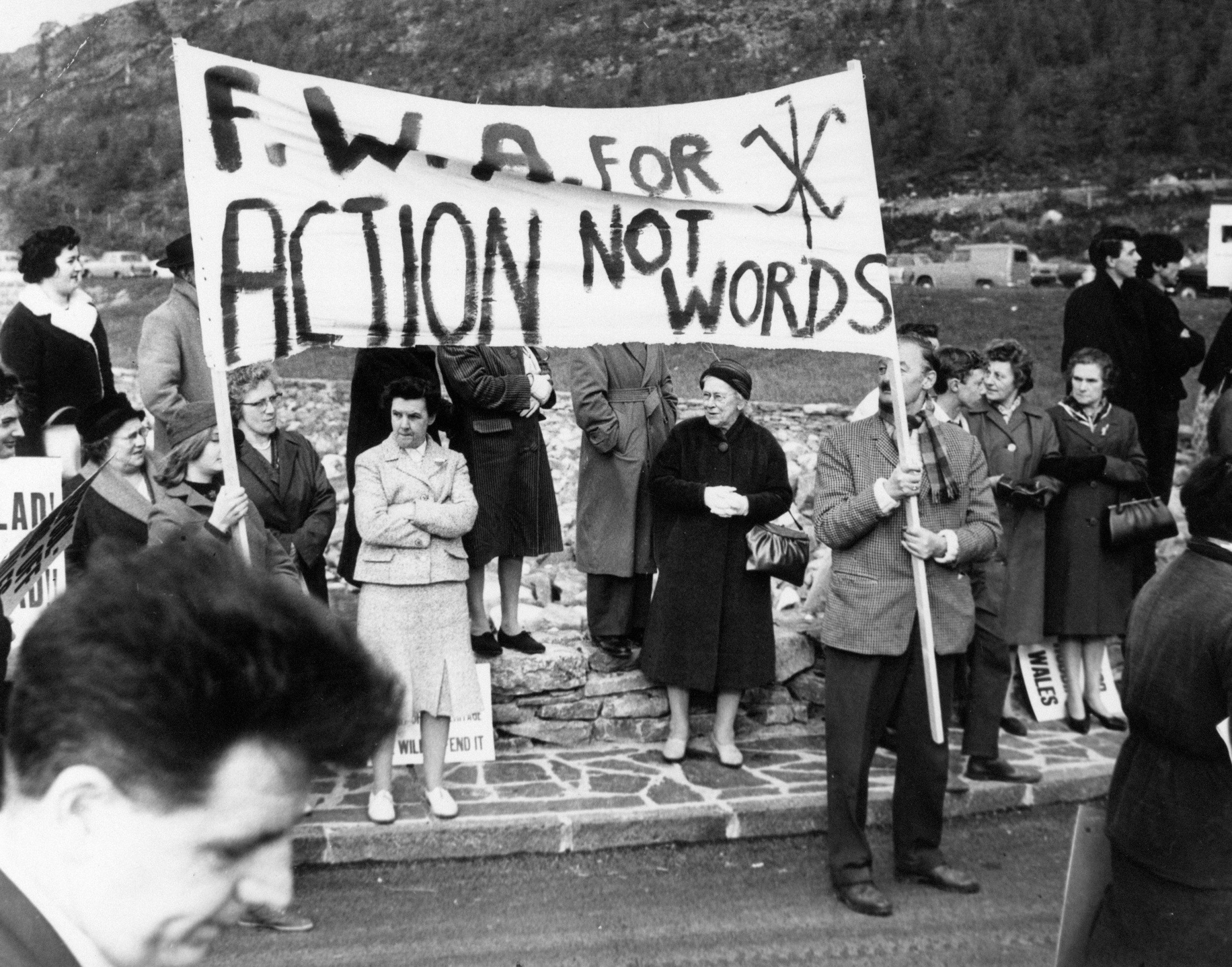
A demonstration in Treweryn valley by the Free Wales Army in November 1965, protesting the building of the Llyn Celyn Reservoir – Trinity Mirror/Mirrorpix/Alamy
Tryweryn was always about much more than a dam and a village; it was a painful reminder of Wales’s age-old lack of political independence, of its powerlessness to shape its own destiny. No doubt this is why the many hundreds of letters sent to Liverpool Town Hall and the Department for Welsh Affairs in Whitehall seethe and boil with rage, their anti-English sentiment somewhat reminiscent of the letters sent more recently to second-home owners in Aberystwyth.
“My advice to the people of Tryweryn,” begins one, “is to shoot the first devil that puts his foot in the valley.”
“Yes – England!” screamed another, “your days are over . . . Hands off Wales!”
The scheme itself is variously described as “a wicked plan” and “sacrilegious plundering”; the councillors of Liverpool Corporation were “snakes in the grass” and “greedy capitalists”. The English were no better than the Soviets, opined another, “taking” a Welsh village as the Russians had seized Hungarian ones and massacred civilians in Budapest.
The Welsh language – the oldest surviving language in these isles – was sacred. It was therefore appalling, agreed the correspondents, that one of Wales’s last solely Welsh-speaking villages was to be obliterated at a time when that very language was so gravely imperilled. Half the population of Wales had spoken Welsh in 1911; by 1950, that figure had fallen to 29 per cent, eroded by English-language cinema, radio, television and newspapers.
The actual dam had not been built yet but with each day that passed, bitter cultural memories amassed in the mental reservoir of the Welsh people. The Welsh, as some of the protesters saw it, had a special connection to the island, being descended from the Celtic tribes who were amongst the earliest inhabitants of Britain. Yet what a hand fate had dealt them – shunted into the western extremity of Britain by the Anglo-Saxon settlers, the border thrust westwards under William the Conqueror, who presided over the growth of that anarchic shadowland called the Marches, a bloody domain of colonist warlords, and Edward I’s conquest of Wales, stamping castles across the coastal landscape.
Its laws emasculated, language became the standard-bearer of Welsh identity; but here, too, the Brythonic language was suppressed, castigated as “sinister” by Henry VIII’s ministers, and relegated to the status of a useless, backward tongue banished from law courts, schools and palaces and mansions, compelling Wales’s landowning classes, and anyone who wanted to get ahead, to learn and speak English.
Yet, against the odds, parts of Wales had survived into the 20th century with the old language and culture intact, due in no small part to the impact of the Reformation, Methodist revival and a revolution in grassroots schooling, which sought to save souls by increasing literacy amongst ordinary people. All of which made it so much more of a tragedy, thought the protesters, that the essence of traditional Welshness found itself under threat, once again.
For some, meek surrender wasn’t an option. One letter arrived in a dainty envelope with a red stamp of a very youthful-looking queen and a beautiful “post early for Christmas” graphic. But inside was a piece of blunt menace, fist-scrawled in block capitals intersecting the ruled lines with diagonal disdain: “THEY TRY”, it warned, “AND WE GO DOWN FIGHTING THE ENGLISH ANY PLACE. THIS WILL BE A LONG WAR.” It was signed “the WRA” – the Welsh Republican Army.
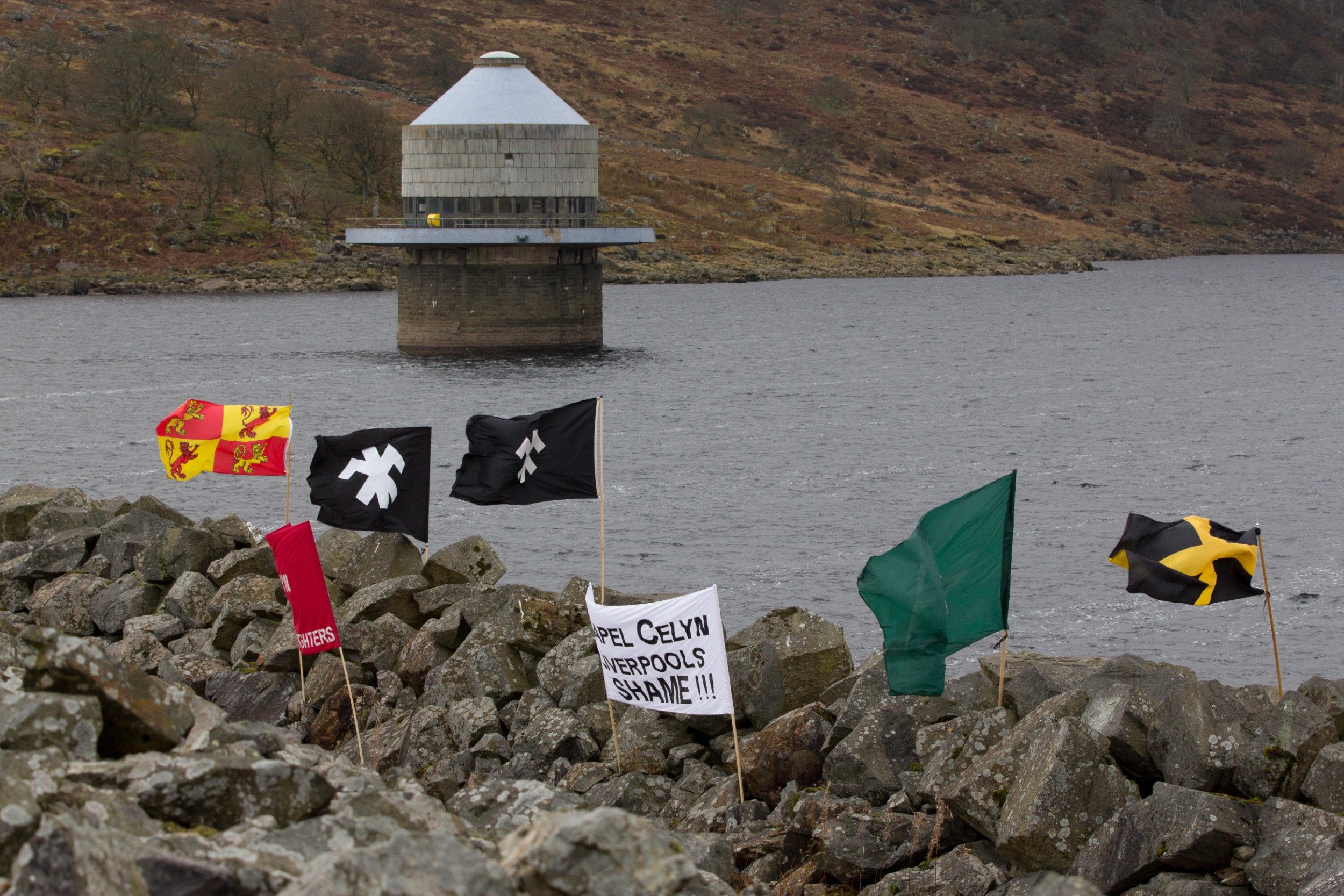
A rally on the Tryweryn Dam in February 2013, commemorating the 50th anniversary of a bomb being exploded on the site by protestors, with assorted protest flags – Alamy
Action accompanied words. The villagers twice marched on Liverpool in the winter of 1956 – as the Corporation was voting on whether to proceed with the drowning. They witnessed the formidable Labour MP and tireless socialist campaigner Bessie Braddock explain in that deep, menacing voice of hers that if Liverpool didn’t secure a new source of water soon, jobs would be lost, living standards would fall, disease would break out, the slum clearance programme would falter, and a wave of crime, suicide and homelessness would roll in. All it would take would be a couple of dry summers, she claimed, and Liverpool would die of thirst.
The first time, Gwynfor Evans was yelled at by a fist-thumping Braddock and bundled out by the police; the second, they won a sympathetic hearing in the Grand Council Chamber, even a thundering ovation, only for the councillors to vote 94 to 1 to proceed anyway.
Liverpool seems genuinely to have believed it was all a storm in a teacup. Had it not welcomed a constant flow of economic migrants from Wales with open arms over the last 200 years? Were there not in fact infinitely more Welsh in Liverpool than in Capel Celyn itself? With adequate compensation and relocation, they thought the valley could be washed away with a minimum of fuss.
There was one last hope for the Capel Celyn protestors: Westminster. But this was a long shot, since English MPs outnumbered Welsh ones by six to one. Still, the Welsh MPs gave it their all. Couldn’t Liverpool just tap the Mersey, they asked? How could the plan even be proposed when half of rural Wales didn’t have running water? And besides, wasn’t the water patently for industrial resale not domestic consumption?
English MPs batted these points away. Yes, the optics were unfortunate, but coldly utilitarian arguments won the day. Dressed in black, wearing her trademark pearl necklace, the nemesis of Tryweryn took to the floor. “Everyone deplores the fact that in the interests of progress sometimes some people must suffer,” said Bessie Braddock, “but that is progress.” The bill passed comfortably. Capel Celyn now found itself in the shadow of annihilation.
Work on the lake began in November 1959. Plaid Cymru never gave up, continuing to produce ever more elaborate schemes to prevent the drowning, but few of the residents had any time for these pipe dreams and reluctantly they made terms. In 1961, Mabel and John Evans posed for one final photograph on the porch of the house where they had lived their entire married life. They repaired to a farm that Liverpool had bought for them in the hills above Bala. It was not so bad – they’d have 34 acres of land and, excitingly, electricity. But they did not have time to enjoy their new home for long. They were both killed soon after in a car crash.
As families trickled out, Capel Celyn was forensically dismantled. The last train to Capel Celyn trundled in on January 2, 1960, accompanied by a funeral band. That summer, clay for the dam’s core was laid down and, not far from the village, gravel was gauged from pits to cover the surface. Up went a grotesquely ironic sign: “Trespassers will be prosecuted”, and the valley degenerated into a dust-ridden wasteland.
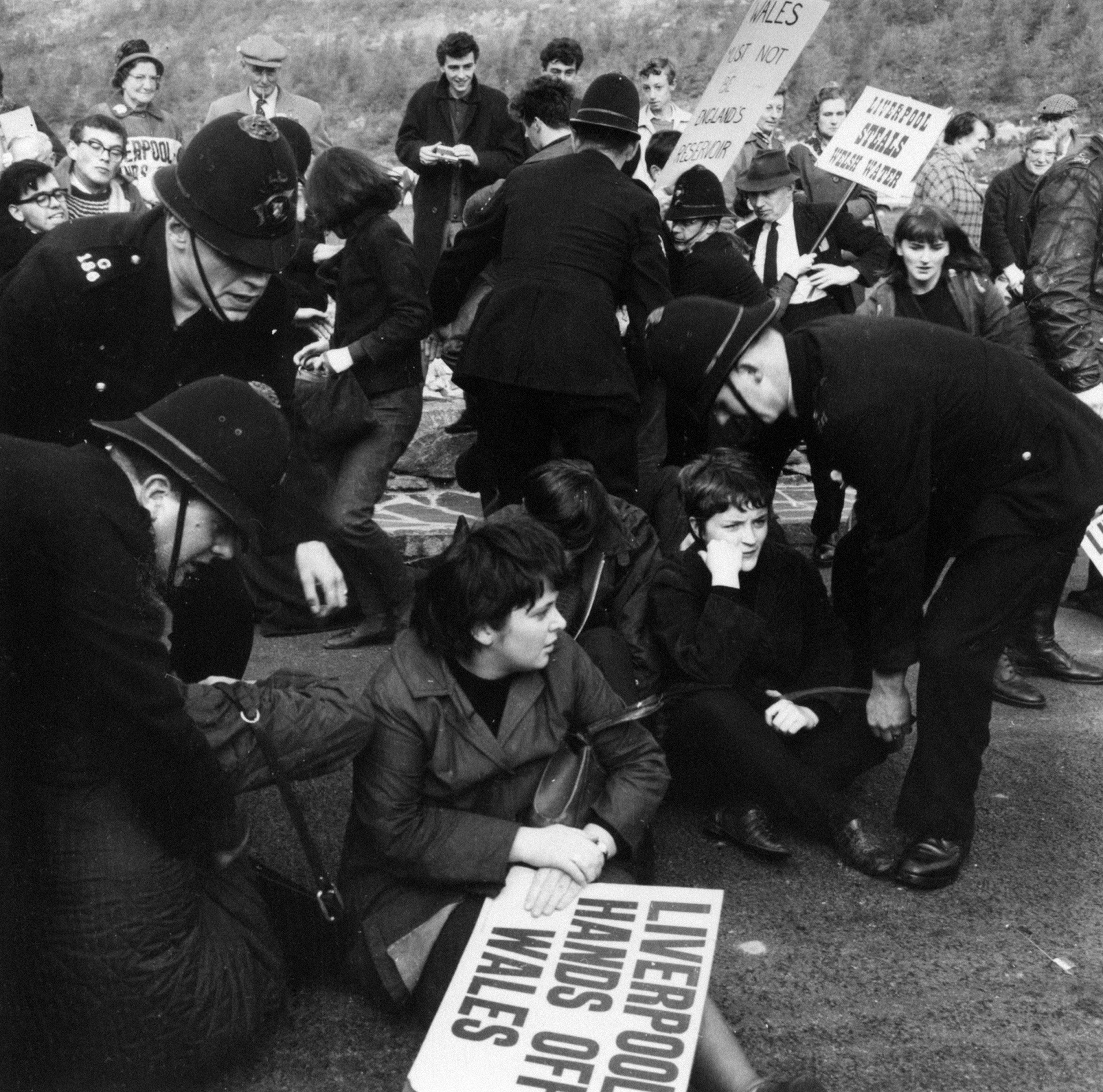
Welsh protestors disrupt speeches by officials from the Liverpool Corporation Waterworks during the official opening of the Llyn Celyn reservoir in October 1965 – Daily Mirror/Mirrorpix/Getty
At three in the morning, on February 10, 1963, as snow fell on the bonnets of bulldozers, a massive explosion tore through the valley. Three men slunk away, the blood of one of them dripping into the snow. The three activists, the farmer’s son Owain Williams, Aberystwyth student Emyr Llewelyn, and former military policeman John Albert Jones, had formed the Movement for the Defence of Wales in an espresso bar. They had managed to destroy a transformer, but were soon caught. Their eventual sentences were lenient, though, as they were heroes to many.
The last church service took place a year before the waters came. The visitors’ book lay on a coffin for people to sign. Afterwards, there was a funereal cheerfulness – they were on camera, of course, and wanted one last image for themselves, of mutual respect, companionship, and close community spirit, for it was precisely these things which were being obliterated. Eight months later, the deconsecrated chapel was ripped down. Some of its stone blocks were insultingly used in the construction of the dam itself. Then, on a bleak misty morning, the agents of the Corporation went to the graveyard to dig up the dead, carefully marking the cobwebbed coffins and driving them off in a truck. If their families preferred, their relatives could be left in their graves, snug beneath a blanket of concrete, marked by a lonely underwater plaque. Many are still down there.
The valley grew starker by the day. All the trees were chopped down, in case they blocked the floodgates; the hedges too. What buildings remained stood like lonely dominoes and when the grouse and swallows flew across Cwm Tryweryn now, they looked down upon an eerie lunar landscape, scoured of life. The older people were devastated. “You could see it in their faces,” recalled Martha Robert Jones. Finally, the basin’s floodgates were closed and the river dammed. Now the rainwater flowing down the Merionethshire hills, finding its path to the sea blocked, amassed in the valley as the lake came into being.

Protestors disrupted the official opening of the Llyn Celyn reservoir in October 1965 by cutting microphone wires and chanting during the official speeches – Daily MIrror/Mirrorpix/Getty
By autumn 1965, it was complete: a magnificent reservoir two and a half miles long and a mile across, with a depth of 43 metres. It was only right that dignitaries from Liverpool should come down to admire their handiwork for a grand opening ceremony and five-course luncheon. Predictably this soon descended into farce: protestors’ placards thwacking down on aldermen’s bonnets, bricks lobbed at the Lord Mayor of Liverpool, and a Union Jack set on fire by the Free Wales Army (they couldn’t get it to stay lit, in the event, and the tattered flag ended up in the reservoir, a vivid emblem of national discord). The Welsh protestors sang a hymn whose words, unbeknownst to the Liverpudlians, meant “all English are arseholes”, and when the Lord Mayor tried to speak he realised the microphone wires had been cut. To cries of “Hands off Wales!” and “You fascist Scouser bastard!” the chairman of the Water Committee yanked on a lever, sending millions of gallons of water spurting from the stilling basin into the river below, drowning out the rousing tones of Land of My Fathers in a monstrous gush just as they, earlier, had drowned him out.
Standing in the twilight, seeing the reservoir fading into an abyss of mist, was one of the most haunting sights I have ever seen. And occasionally, the village reappears. During the droughts of 1976, 1986, 1989, 1995 and 1998 people were able to walk its old high street. Everywhere were ruins, a Golgotha of stubs, roots and waste. Mysteriously, some of the stubs of houses had suspiciously fresh-looking slogans spray-painted on their sides: “DROWNED BY ENGLISH PIGS” and “WE WILL REBUILD” in a continuity of sabotage.
But ghostly apparitions are not necessary to sustain the memory of the village. “Tryweryn” has become both a byword for courageous resistance to an act of tyranny and a rallying call for the protection of Welsh language and identity. In the 1960s and 1970s, when the campaign to protect the Welsh language reached its peak, you could see “Cofiwch Dryweryn” (Remember Tryweryn) all over Wales, daubed on bridges and buildings. Most have vanished, although one can be seen by the side of the A487, overlooking the seaside village of Llanrhystud, some 60 miles from Llyn Celyn. The Manic Street Preachers song Ready for Drowning is about the outrage and in series three of The Crown it provided context as one of the reasons why people were so bitter about Charles’s investiture as Prince of Wales in 1969. In Merionethshire at least, the memory is still poignant. In the archives, one woman told me she lived near the lake and had called her daughter Celyn; there is apparently a cluster of children called Celyn, all perpetuating the memory of the vanished village.
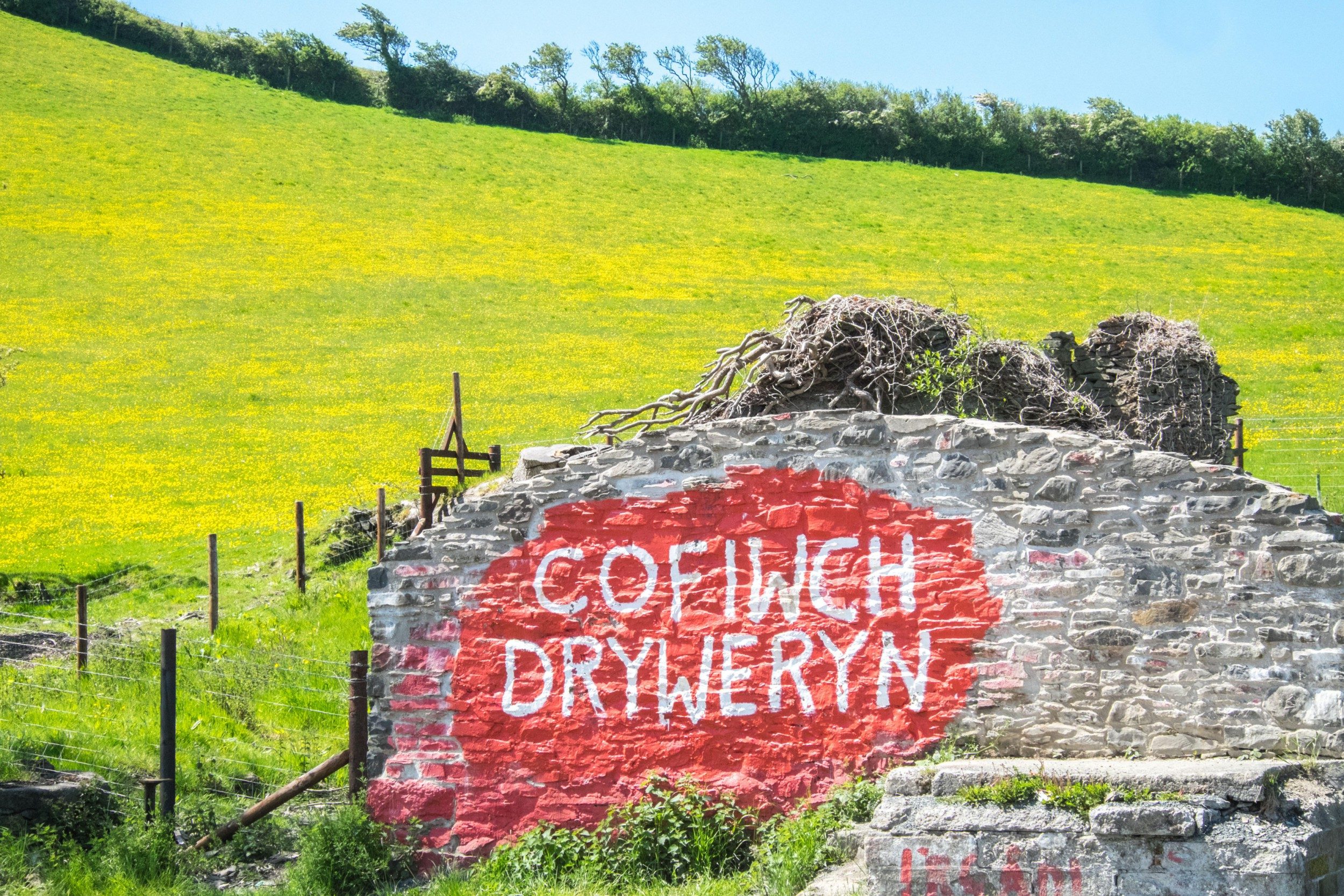
A mural announcing ‘Cofiwch Dryweryn’ (Remember Treweryn) on the A487 at Llanrhystud, south of Aberystwyth, around 60 miles from the site of Capel Celyn. Similar graffiti was once popular all around Wales – Paul Quayle/Alamy
Capel Celyn did not die in vain. It inspired people to teach their children Welsh (the number of Welsh speakers is currently rising) and contributed to the establishment of a Welsh-language BBC channel in 1964. It led, too, to the establishment of the office of Secretary of State for Wales in 1964. No doubt some of these developments would have happened anyway, but Tryweryn gave them a fillip. Whether there is much of a link between the drowning of the valley in the 1960s and the inauguration of the Welsh Assembly (now the Welsh Parliament) in 1999 is less clear-cut – the Welsh overwhelmingly rejected the very same thing in a referendum in 1979, and Tryweryn isn’t evoked by Plaid Cymru, still a relatively minor force in Welsh politics, all that often. But we can say that the “white-hot indignation” fomented by Liverpool’s handling of the affair galvanised the age-old quest for Welsh self-determination, even if that quest played out in various complex ways.
In 2005, Liverpool Corporation finally apologised for the “hurt of 40 years ago”. But for those who remembered the drowning, this was too little too late. Elwyn Edwards, who had gone on the Liverpool march as a schoolboy, was 22 when the river was dammed. “We lost our heritage,” he says; “we lost everything.” For him and his family it is not a lake at all. It is a graveyard.
Cofiwch Dryweryn.
Dr Matthew Green is the author of Shadowlands: A Journey through Lost Britain (Faber), out now in paperback. He also leads immersive walking tours of Lost London.
%n
Sign up to the Front Page newsletter for free: Your essential guide to the day’s agenda from The Telegraph – direct to your inbox seven days a week.
News Related-
Antoine Dupont still hurt by 'injustice' of World Cup loss to Springboks
-
China's New Aircraft Carrier Begins Catapult Testing
-
Aircraft Downed Inside Russia By Patriot System: Ukrainian Air Force
-
“Am I Prog’s Taylor Swift? That’s a debate that could run and run”: why Peter Hammill re-recorded his Enigma-era albums
-
Car With Pro-Russian Fighters Blown Up by Resistance: Exiled Mayor
-
Europe and African nations must find effective common ground in dealing with migration influx
-
Springbok lock opts not to renew contract with URC team
-
Pravin Gordhan’s deathly legacy: A threat to SA’s economic future
-
Antoine Dupont STILL hurt by ‘injustice’ of Rugby World Cup loss to Springboks
-
Rubber stamping NHI Bill will have damaging consequences for SA for generations
-
Inside horrific conditions Hamas hostages suffered including losing 15lbs in 50 days
-
After the Bell: SA’s NHI healthcare disaster starts right here
-
Gupta-linked development land for sale
-
Gary Neville begrudgingly claims brilliant Man Utd midfielder ‘looked like a Man City player’ in Everton mauling
